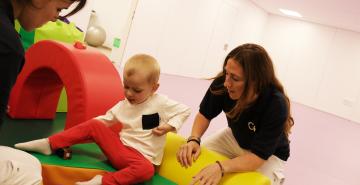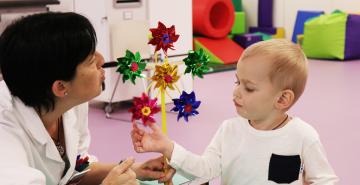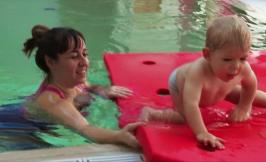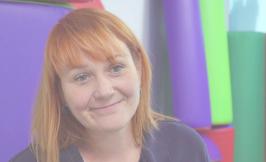Childhood Stroke
Stroke is damage of acute onset that brings about an injury with different neurological consequences depending on the area that has been affected. It is difficult to diagnose due to the possibility of confusion with regard to symptoms. It is important to differentiate between cerebrovascular accidents in children and those that occur in adults, since both the origin and the consequences are different.
From birth and even before, children run the risk of suffering a stroke and therefore of suffering its sequelae. These sequelae are related to the severity of the injury, the age at which it occurs and how quickly the medical and therapeutic teams intervene. Although the incidence is lower in children than in adults, it is one of the ten leading causes of infant mortality. We have to bear in mind that the risk factors for childhood stroke are totally different in this population (perinatal or postnatal) and that in many cases it is impossible to find out the trigger behind the damage. In childhood strokes, we should distinguish between two major groups:
- Neonatal or perinatal arterial stroke, when the stroke occurs between the 20th week of gestation and 28 days of postnatal life.
- Postnatal arterial stroke, if the stroke occurs later than 28 days after birth.
The incidence of stroke or cerebrovascular accident in children under 15 years of age is approximately 6 cases per 100,000 children each year. Heart disease is one of the most common risk factors for childhood stroke and is considered responsible for 30% of cases. Vascular strokes are slightly more common in children under the age of two.
- Causes of childhood stroke
-
In adults, the causes of stroke can often be blows, high blood pressure, high cholesterol, a history of smoking, excess alcohol or obesity. In contrast, the causes in children are more often:
- Birth defects
- Infections (for example, meningitis, encephalitis)
- Trauma, operations
- Blood disorders such as sickle cell anaemia
- Symptoms of childhood stroke
-
We should all know the symptoms of childhood stroke in order to act quickly. The public lack knowledge about the possibility of a childhood stroke, which causes intervention to be delayed and therefore aggravates the sequelae. We can observe the following symptoms in children.
- Facial spasms and/or dystonia
- Apnoea associated with catatonic episodes
- Lack of mobility
- High-intensity sudden onset headache
- Vomiting and/or nausea
- Abrupt sensitivity disorder in the face, arm or leg on one side of the body
- Sudden muscle weakness on one side of the body
- Difficulty speaking or understanding what is being said
- Vision disorders
- Loss of balance
-
On average, it takes 12 to 24 hours to reach the hospital in adult strokes after the first symptoms have been recognised, rising abruptly to an interval of 48 to 72 hours in cases seen in very young children.
- Sequelae of childhood stroke
-
The idea exists that a prognosis of stroke in childhood, particularly the ischaemic type, has a better prognosis than that in adults, given the greater plasticity of a child’s brain.
Although strokes can be devastating in children, they can be cured more easily due to the higher degree of flexibility of their nervous system and brain. A child’s brain is still developing, so it has a bigger capacity to repair itself. With the help of physiotherapy and speech therapy, many children who have had a childhood stroke regain the use of their arms, legs and speech. The main consequences described are difficulties with language, attention, memory, visual skills and executive functioning. To these cognitive deficits we should add the emotional and behavioural difficulties that also appear, with all of these factors clearly affecting the child’s quality of life.
- Motor impairment
- Epilepsy
- Sensitivity impairment
- Spasticity
- Visual impairment
- Language impairment
- Cognitive impairment
- Conduct and behavioural changes

Social skills training is aimed at children and adolescents who have difficulties in interpersonal relationships and in handling different social situations, either because they have a disorder that justifies these issues.

The Psychological treatment with Cognitive behavioural therapy brings together two types of therapeutic treatments, because although behavioural therapies are successful in the treatment of some pathologies, other aspects involved in the way in which people respond to different situations have to be taken into account.
The treatment of children’s cognitive telerehabilitation with Guttmann, NeuroPersonalTrainer® (GNPT®) is an active process that helps children with cognitive disorders, learning difficulties or behavioural problems to:

During the first sessions of child physiotherapy, we examine the child and collect all the data needed to set up a personalised programme, including an interview with the family to find out relevant aspects in order to establish the most appropriate plan for the child’s recovery:

In order to devise a child occupational therapy treatment programme adapted to the needs of each individual child, several key aspects are explored in the first sessions:

Child speech therapy begins with an assessment involving a physical examination of the child and the administration of standardised tests and questionnaires.

The Child Neuropsychological Intervention always takes place in individualised sessions which work individually with each child or young person.

Music therapy is one of the treatment options available at Guttmann Barcelona, for both adult and paediatric patients affected by neurological injuries or diseases at different stages within the rehabilitation process.
Et pot interessar
 Wednesday, 21 August, 2024
Neonatal and childhood dysphagia: keys to detecting and treating swallowing difficulties
Wednesday, 21 August, 2024
Neonatal and childhood dysphagia: keys to detecting and treating swallowing difficulties
What do we mean by dysphagia? The European Society for Swallowing Disorders (ESSD) defines dysphagia as the medical term used to represent...
 Thursday, 17 February, 2022
Aphasia, a consequence of brain damage
Thursday, 17 February, 2022
Aphasia, a consequence of brain damage
Types of aphasia and evolution People with non-fluent aphasia show reduced expression, often with difficulty articulating words. Their...
 Monday, 30 March, 2020
Robótica para la rehabilitación
Monday, 30 March, 2020
Robótica para la rehabilitación
El uso de la tecnología en el marco de un programa de rehabilitación integral ofrece la oportunidad de aumentar la intensidad y la...



